如何访问Google以及使用谷歌搜索客户
- 格式:doc
- 大小:2.83 MB
- 文档页数:9

1、产品名(Products name)+公共邮箱名后缀1)产品+通用邮箱后缀如:ball valve @,ball valve @,ball valve @,ball valve @2)产品+Y ahoo各国邮箱后缀:@yahoo.co.jp,@, 如在www.yahoo.co.jp 输入“ball valve @yahoo.co.jp”或“ボールバルブメール”(ball valve email)产品+Live各国邮箱后缀,@ 如在输入"球阀email"3) Google各国的版本搜索,譬如输入"球阀Email"4)产品名称+importers+email产品名称+distributors+email产品名称+wholesaler+email产品名称+buyer+email产品名称+supplier+emailemail还可用@代替5)产品+地区公共邮箱后缀或“产品+buy+地区邮箱”美国:@,@,@,@,@,@,@; 德国@t-online.de,@multi-industrie.de;法国:@wannado.fr,@,@,@club-internet.fr;日本@yahoo.co.jp,@candel.co.jp;英国@,@,@sltnet.lk;印度@ @.in @ @sancharnet.in @ @.in新西兰@俄罗斯@yandex.ru @mail.ru德国@t-online.de @multi-industrie.de香港@ @ @ @ @@ @ @台湾省@.tw @ @新加坡@.sg以色列:@.il;@candel.co.jp;@.il @.il @fastmail.fm赞比亚:@zamnet.zm阿根廷:@.ar; @.ar马其顿:@.mk几内亚:@.gn墨西哥:@.mx法国:@wannado.fr @ @ @club-internet.fr津巴布韦:@africaonline.co.zw;@samara.co.zw;@zol.co.zw;@mweb.co.zw科特迪瓦:@aviso.ci;@africaonline.co.ci;@纳米比亚:@.na;@;@iway.na;@尼泊尔:@.np;@.np;@.np蒙古:@; @mail.mn汤加:@kalianet.to; 阿塞拜疆:@mail.ru日本@yahoo.co.jp @candel.co.jp 阿曼@.om南非@webmail.co.za @vodamail.co.za @爱尔兰@indigo.ie @ 特阿拉伯@.sa瑞典@caron.se 希腊@.gr @otenet.gr泰国@ @澳大利亚@ @.all @.au @.au @eunet.at卡塔尔@.qa 英国@ @ @sltnet.lk加拿大@ @马来西亚@.my韩国的@/net @ @() @ @ @ @ @yahoo.co.kr巴基斯坦:@.pk @ @.in @ @sancharnet.in @.in @.in阿拉伯联合酋长国@.ae 科威特:@越南:@hn.vnn.vn @hcm.fpt.vn @hcm.vnn.vn孟加拉:@ 意大利:@xxx.meh.es @terra.es @libero.it科特迪瓦:@aviso.ci @africaonline.co.ci @纳米比亚:@.na @ @iway.na @阿塞拜疆:@mail.ru 印尼:@.id巴西:@ 联合国:@ @日耳曼:@ 奥地利:@eunet.at波兰:@ @poczta.onet.pl挪威:@ 埃及:@其他国家的公共EMAIL后缀可以通过自己的客户EMAIL后缀或者在Google搜索"国家名称+email",2、B2B采购信息+email到Google搜索一般B2B都有公布采购信息的部分信息,如公司名称,地址等,要想获得此公司的EMAIL 可采取在Google搜索此买家的"电话+EMAIL","公司名称+Email"等等3、公司名称后缀+产品名称+EMAIL中国的是Co., LTD,美国是INC;LLC等,意大利是S.R.L; 西班牙是S.P.A.等等4、展会搜索展商EMAIL先通过Google搜索展览会,找出展商列表,再到Google搜索展商名称+EMAIL5、行业品牌的distributor或dealer的EMAIL搜索6、用alexa找出跟行业品牌链接的网站在Alexa的Trafic ranking里输入 可以找出的related link网站,这些公司的EMAIL找出来,是否有商机呢?7、世界各地的协会/工会网站找出协会会员,再到Google搜索EMAIL。
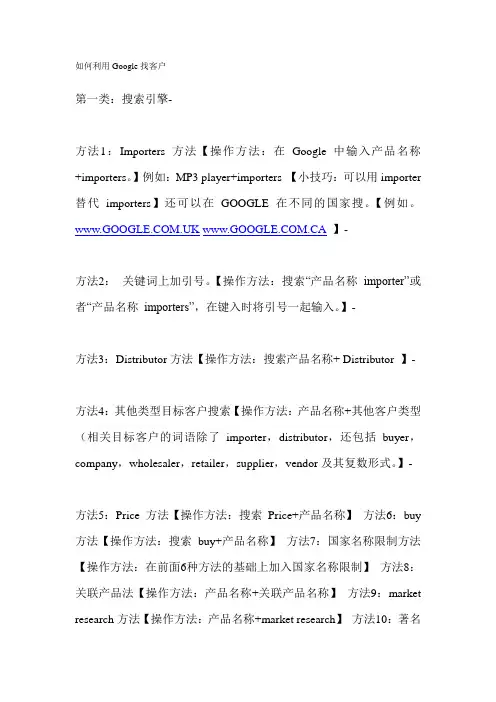
如何利用Google找客户第一类:搜索引擎-方法1:Importers方法【操作方法:在Google中输入产品名称+importers。
】例如:MP3 player+importers 【小技巧:可以用importer 替代importers】还可以在GOOGLE在不同的国家搜。
【例如。
.CA】-方法2:关键词上加引号。
【操作方法:搜索“产品名称importer”或者“产品名称importers”,在键入时将引号一起输入。
】-方法3:Distributor方法【操作方法:搜索产品名称+ Distributor 】-方法4:其他类型目标客户搜索【操作方法:产品名称+其他客户类型(相关目标客户的词语除了importer,distributor,还包括buyer,company,wholesaler,retailer,supplier,vendor及其复数形式。
】-方法5:Price 方法【操作方法:搜索Price+产品名称】方法6:buy 方法【操作方法:搜索buy+产品名称】方法7:国家名称限制方法【操作方法:在前面6种方法的基础上加入国家名称限制】方法8:关联产品法【操作方法:产品名称+关联产品名称】方法9:market research方法【操作方法:产品名称+market research】方法10:著名买家法【操作方法:产品名称+你的行业里面著名买家的公司简称或者全称】方法11:观察搜索引擎右侧广告【操作方法:搜索产品名称后,查看搜索结果右侧广告】方法12:寻找行业展览网站--第二类高级搜索引擎-方法13:高级搜索的title方法【操作方法:使用google高级搜索功能的Allintitle功能,搜索上述各个项目的关键词一般来说,前面介绍的12种方法使用title方法后,都能够加强结果的准确性和买家信息的相关性。
】-方法14:寻找有连接到大客户网站的网页-操作方法:使用google查找大客户网站的连接【这种方法查找出来的连入网页主要有如下情况:该页面有该客户的广告、该页面推荐了该客户、该页面谈论到了该客户】-方法15:寻找有引用大客户网址的网页【操作方法:同上述方法,只是查找的是引用客户网址的页面,而不是连入页面】-方法16:网址包括大客户公司名【操作方法:使用google高级搜索功能,输入大客户名称,在字体位置选择“网页内的网址”搜索】-方法17:多种语言方法【操作方法:搜索关键词的其他语言书写】-方法18:专业文档方法【搜索引擎还提供类似PPT、PDF、word、excel 文档的高级搜索功能。
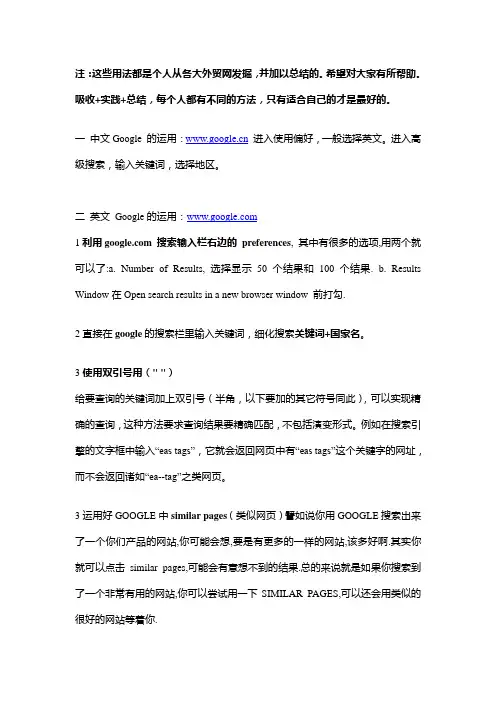
注:这些用法都是个人从各大外贸网发掘,并加以总结的。
希望对大家有所帮助。
吸收+实践+总结,每个人都有不同的方法,只有适合自己的才是最好的。
一中文Google 的运用:进入使用偏好,一般选择英文。
进入高级搜索,输入关键词,选择地区。
二英文Google的运用:1利用 搜索输入栏右边的preferences, 其中有很多的选项,用两个就可以了:a. Number of Results, 选择显示50个结果和100个结果. b. Results Window 在Open search results in a new browser window 前打勾.2直接在google的搜索栏里输入关键词,细化搜索关键词+国家名。
3使用双引号用(" ")给要查询的关键词加上双引号(半角,以下要加的其它符号同此),可以实现精确的查询,这种方法要求查询结果要精确匹配,不包括演变形式。
例如在搜索引擎的文字框中输入“eas tags”,它就会返回网页中有“eas tags”这个关键字的网址,而不会返回诸如“ea--tag”之类网页。
3运用好GOOGLE中similar pages(类似网页)譬如说你用GOOGLE搜索出来了一个你们产品的网站,你可能会想,要是有更多的一样的网站,该多好啊.其实你就可以点击similar pages,可能会有意想不到的结果.总的来说就是如果你搜索到了一个非常有用的网站,你可以尝试用一下SIMILAR PAGES,可以还会用类似的很好的网站等着你.4 点击google 左上角的images (图像),在搜索栏中输入关键词。
出现一系列同产品相关的图像,点击进去有的链接公司网站,可以找到email。
细化搜索关键词+国家名5点击google 左上角的Maps(地图)功能,输入关键词+国家名搜索,可以清晰看到实物信息。
6点击google 左上角的shopping功能。
输入关键词or 关键词+国家名。
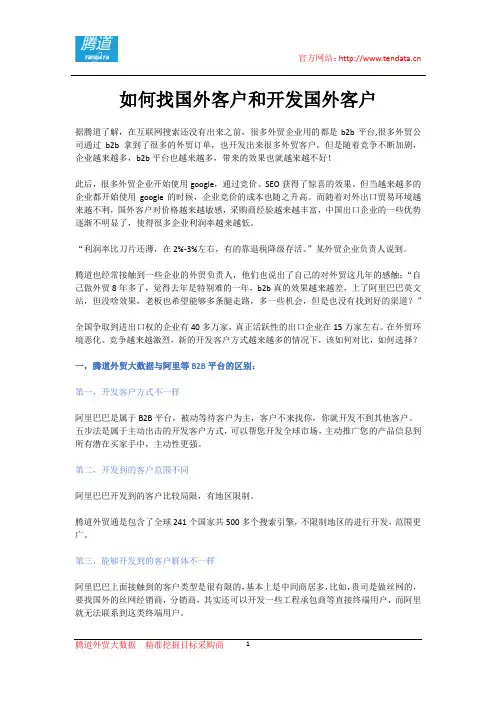
如何找国外客户和开发国外客户据腾道了解,在互联网搜索还没有出来之前,很多外贸企业用的都是b2b平台,很多外贸公司通过b2b拿到了很多的外贸订单,也开发出来很多外贸客户。
但是随着竞争不断加剧,企业越来越多,b2b平台也越来越多,带来的效果也就越来越不好!此后,很多外贸企业开始使用google,通过竞价、SEO获得了惊喜的效果。
但当越来越多的企业都开始使用google的时候,企业竞价的成本也随之升高。
而随着对外出口贸易环境越来越不利,国外客户对价格越来越敏感,采购商经验越来越丰富,中国出口企业的一些优势逐渐不明显了,使得很多企业利润率越来越低。
“利润率比刀片还薄,在2%-3%左右,有的靠退税降级存活。
”某外贸企业负责人说到。
腾道也经常接触到一些企业的外贸负责人,他们也说出了自己的对外贸这几年的感触:“自己做外贸8年多了,觉得去年是特别难的一年,b2b真的效果越来越差,上了阿里巴巴英文站,但没啥效果,老板也希望能够多条腿走路,多一些机会,但是也没有找到好的渠道?”全国争取到进出口权的企业有40多万家,真正活跃性的出口企业在15万家左右。
在外贸环境恶化、竞争越来越激烈,新的开发客户方式越来越多的情况下,该如何对比,如何选择?一,腾道外贸大数据与阿里等B2B平台的区别:第一,开发客户方式不一样阿里巴巴是属于B2B平台,被动等待客户为主,客户不来找你,你就开发不到其他客户。
五步法是属于主动出击的开发客户方式,可以帮您开发全球市场,主动推广您的产品信息到所有潜在买家手中,主动性更强。
第二,开发到的客户范围不同阿里巴巴开发到的客户比较局限,有地区限制。
腾道外贸通是包含了全球241个国家共500多个搜索引擎,不限制地区的进行开发,范围更广。
第三,能够开发到的客户群体不一样阿里巴巴上面接触到的客户类型是很有限的,基本上是中间商居多,比如,贵司是做丝网的,要找国外的丝网经销商,分销商,其实还可以开发一些工程承包商等直接终端用户,而阿里就无法联系到这类终端用户。
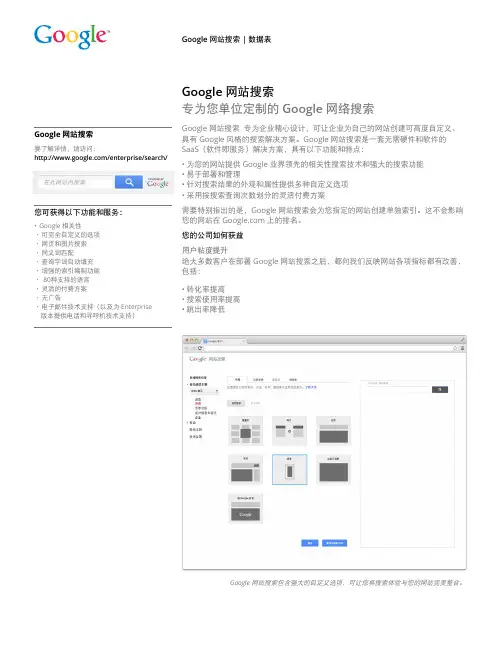
Google 网站搜索 | 数据表Google 网站搜索专为您单位定制的 Google 网络搜索Google 网站搜索 专为企业精心设计,可让企业为自己的网站创建可高度自定义、具有 Google 风格的搜索解决方案。
Google 网站搜索是一套无需硬件和软件的 SaaS (软件即服务)解决方案,具有以下功能和特点:• 为您的网站提供 Google 业界领先的相关性搜索技术和强大的搜索功能 • 易于部署和管理• 针对搜索结果的外观和属性提供多种自定义选项 • 采用按搜索查询次数划分的灵活付费方案需要特别指出的是,Google 网站搜索会为您指定的网站创建单独索引。
这不会影响您的网站在 上的排名。
您的公司如何获益用户粘度提升绝大多数客户在部署 Google 网站搜索之后,都向我们反映网站各项指标都有改善,包括:• 转化率提高 • 搜索使用率提高 • 跳出率降低Google网站搜索包含强大的自定义选项,可让您将搜索体验与您的网站完美整合。
Google 网站搜索要了解详情,请访问:/enterprise/search/您可获得以下功能和服务:• Google 相关性• 可完全自定义的选项• 网页和图片搜索• 同义词匹配• 查询字词自动填充• 增强的索引编制功能• 80种支持的语言• 灵活的付费方案• 无广告• 电子邮件技术支持(以及为 Enterprise版本提供电话和寻呼机技术支持)客户满意度提升客户普遍希望获得像 上一样的搜索体验,而 Google 网站搜索能够在客户使用的任意设备上提供这样的搜索体验。
易于管理Google 网站搜索的注册和管理通过在线控制台进行处理。
您提供想要 Google 网站搜索编入索引的网站后,这些网页将在数小时内被编入索引。
您还可以任意指定不同方式来对搜索体验进行自定义,无论是外观,还是搜索结果的提供方式和内容,都能自行设定。
其中很多功能都可由非技术人员操作,不过我们还提供了一些更高级的自定义选项。
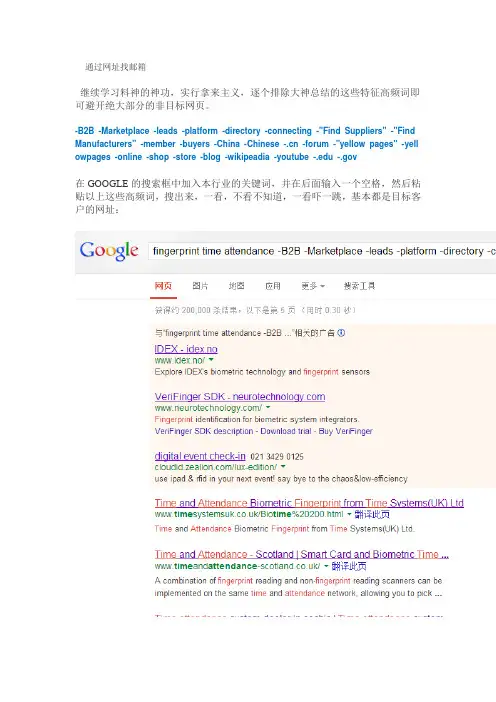
通过网址找邮箱
继续学习料神的神功,实行拿来主义,逐个排除大神总结的这些特征高频词即可避开绝大部分的非目标网页。
-B2B -Marketplace -leads -platform -directory -connecting -"Find Suppliers" -"Find Manufacturers" -member -buyers -China -Chinese -forum -"yellow pages" -yell owpages -online -shop -store -blog -wikipeadia -youtube
在GOOGLE的搜索框中加入本行业的关键词,并在后面输入一个空格,然后粘贴以上这些高频词,搜出来,一看,不看不知道,一看吓一跳,基本都是目标客户的网址:
如果有的网址上是没有邮箱的,可以试下以下方法:
1,GOOGLE搜索栏上输入:CEO 或 purchasing 等字样@域名进行搜索,如下图
图片:45_副本.jpg
2,还可以输入公司网址空格 mail,看看会出来什么
3,再或者举一反三,公司网址空格 mail空格site:国家后缀,看看又有什么不同
通过以上查找不难看出,外贸除了需要聪明才智,更需要吃得苦,霸得蛮,耐得烦,燎得难的精神,加油吧,童鞋们,向神的方向冲刺啊!。
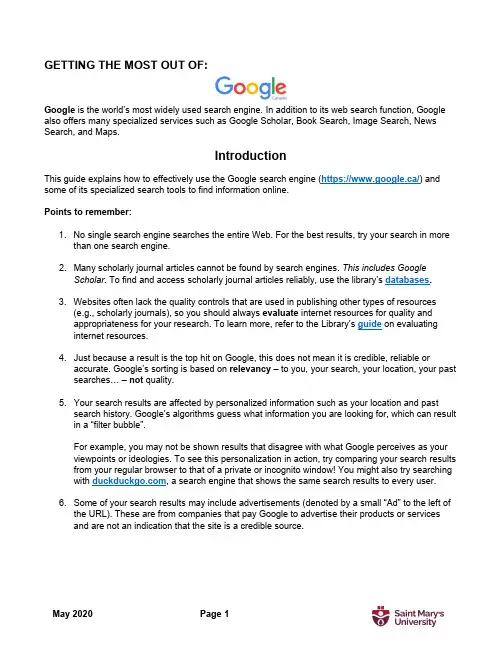
GETTING THE MOST OUT OF:Google is the world’s most widely used search engine. In addition to its web search function, Google also offers many specialized services such as Google Scholar, Book Search, Image Search, News Search, and Maps.IntroductionThis guide explains how to effectively use the Google search engine (https://www.google.ca/) and some of its specialized search tools to find information online.Points to remember:1.No single search engine searches the entire Web. For the best results, try your search in morethan one search engine.2.Many scholarly journal articles cannot be found by search engines. This includes GoogleScholar. To find and access scholarly journal articles reliably, use the library’s databases.3.Websites often lack the quality controls that are used in publishing other types of resources(e.g., scholarly journals), so you should always evaluate internet resources for quality andappropriateness for your research. To learn more, refer to the Library’s guide on evaluatinginternet resources.4.Just because a result is the top hit on Google, this does not mean it is credible, reliable oraccurate. Google’s sorting is based on relevancy – to you, your search, your location, your past searches… – not quality.5.Your search results are affected by personalized information such as your location and pastsearch history. Google’s algorithms guess what information you are looking for, which can result in a “filter bubble”.For example, you may not be shown results that disagree with what Google perceives as your viewpoints or ideologies. To see this personalization in action, try comparing your search results from your regular browser to that of a private or incognito window! You might also try searching with , a search engine that shows the same search results to every user.6.Some of your search results may include advertisements (denoted by a small “Ad” to the left ofthe URL). These are from companies that pay Google to advertise their products or servicesand are not an indication that the site is a credible source.Basic SearchGoogle search has some customizable features and will perform differently depending upon which settings are selected.Google has a built-in Autocomplete feature that is not possible to turn off. As you are typing your query, Google makes predictions about possible search terms for you. However, it is not necessary to choose any of the predictions.Google has an option to include Private results that can look for tailored content for you from other Google products you use, like Gmail or Google Calendar. This only works if you are signed into your Google account while searching, and it can be turned off by going into Settings and selecting Do not use private results .Searching with Google:To perform a search with Google, enter your keywords into the search box.When you have entered your keywords, either click on one of the Autocomplete predictions, hit Enter on your keyboard, or click on the search button on the browser.Search termsAutocomplete predictions Voice Search:To use Voice Search, click on the microphone icon in the search bar and follow the instructions. When choosing search terms:•Be specific and try to include at least 2 keywords that best describe what you are trying tofind. For example, to find apartments for rent in Halifax, you could search:•Avoid common words such as “how”, “of”, and “where” because these stop words will normallybe excluded from a search. If stop words occur in a common phrase or title such as Of Mice and Men , use quotation marks to search for the exact set of words:•Select appropriate terminology for your query and be aware that different terms may imply a certain bias:e.g., searching “oil sands” will retrieve results from Alberta Energy and other members ofthe oil industry, whereas a search for “tar sands” will retrieve results from Greenpeaceand other environmental advocacy organizations.•Word order can affect your search results. Words should be ordered in the way you would expect them to appear in a search result or how they appear in natural phrases:e.g., “world war” retrieves results about the First and Second World Wars, whereas “warworld” retrieves results about a DC comic book series.Writing a Search QueryWhen searching, it helps to understand how Google interprets what you enter:•Google searches for pages that contain as many of your terms as possible. However, it may return results without some of the terms you entered.o If a result is missing a search term, below its entry you will see: “Missing: term”•Google searches are not case sensitive.•Google automatically searches for variations of some search terms, e.g., “knit”, “knits”, “knitting”, etc. To prevent searching for variations of a term, enclose it in quotation marks.•You don’t need to type AND between your search terms.Basic Search OperatorsORe.g., canine OR dog OR puppy Finds pages that contain one or more of the search terms.–e.g., titanic –moviee.g., biology –site: Exclude particular words, phrases or sites from your results.Google’s version of the “NOT” operator.Can be combined with other special operators, such as site:“ ”e.g., “life of pi”Finds pages that contain the phrase exactly as typed between thequotation marks.*e.g., “* for an * makes thewhole world blind” Use the asterisk as a wildcard for unknown terms. Phrase search with quotations for variations of an exact phrase.Advanced SearchTo use advanced search, click on Settings in the bottom-right of the Google homepage and select Advanced Search from the pop-up menu.If you are in a search already, Settings will appear below the search bar. Or, visithttps://www.google.ca/advanced_search .First, type your search terms into the relevant search boxes:Then, refine your search by selecting one or more limit options, which are listed next to the searchboxes.Refining Your SearchIf your searches are retrieving too many irrelevant hits, use these special operators to increase the relevancy of your results:Special Search Operatorsintitle: Restrict your results to documents with a specified search term in the titlee.g., forensics intitle:universityallintitle: Restrict your results to documents with all of your search terms in the titlee.g., allintitle:google tutorialsite: Restrict your results to documents within a specified website or domaine.g., chemistry site:www.smu.cainurl: Restrict your results to documents with a specified search term in the URLe.g., book review inurl:librarydefine: Google tries to define the term first using dictionaries or encyclopaedias.e.g., define:deep webfiletype: Restrict your results to specific file types using file extensionse.g., syllabus filetype:docxe.g., thesis filetype:pdfrelated: Restrict your results to find webpages with similar content to a specific URLe.g., related:http://www.smu.ca/Note: do not place a space after the colon when using special operators.Google Search Results & Other Search ToolsYour searches could retrieve a variety of content, including links to books, news, images, etc. To limit your results to a particular format, e.g., images, simply select the Images tab located below the search bar on the results page. It is important to note that the placement of these links may change with every search. In the example below, Google Books results are hidden under the More tab, alongside Shopping, Flights, Finance, and Personal.Google Scholar does not appear in the tab below the search bar or in the “More” tab. Instead, Google may suggest “Scholarly articles for Your Search ”. This link will take you to Google Scholar .Google Books , Scholar , Images , News , and Maps also have their own dedicated sites and searchinterfaces. You can use the square “apps” button to access these products. The “apps” button appears at the top right hand side of many Google products, and displays a selection of “popular” apps by default. Image SearchNot to be confused with Google Photos, which is a tool for syncing, editing and sharing pictures.This feature allows you to search for images throughout the web. Enter keywords into the search box and if Google finds any matches to your query, it will display thumbnail pictures of the matches. Click on the thumbnails to view the full sized pictures.You can also upload an image, or paste an image’s URL, to search the web for images that are visually similar to that image. This can be useful for identifying the provenance or original source of an image.News On the Google News homepage, Google sorts its top news stories into various categories (e.g.,Canada, Health, etc.). Thousands of news sources, including traditional news sites, blogs, satire, and press releases are indexed by Google News . While many articles are free to access, some sources have paywalls and will limit the number of articles you are able to view without a subscription.Google News will also alter its contents based on your past searches and preferences. You may notice your favourite news websites appearing more frequently than ones you click on less often.Book SearchThis feature allows you to search the full-text of many books. Google has amassed a collection of scanned books through its affiliations with some prominent libraries, as well as through a partner program with publishers and authors who wish to have their books searchable by the public.Click on a book title and you will see basic bibliographic information about the book. If available, the full-text of the book will be viewable and available for download as a PDF. For some books you will onlybe able to “preview” some full-pages of titles. Other titles only offer “snippet” views of a few lines of text, showing full-text search results in context.If on campus, select the Find in a library (under Get thisbook in print) link and you will be directed to WorldCatLocal for SMU. Here you will be able to see if the item isavailable at the Patrick Power Library or through anotherNovanet library.Search within the full-text of the book for particular termsor phrases.MapsWith Google Maps, you can search for maps and directions to various locations (e.g., cities, streets, or restaurants). Browse streetscapes and explore landmarks as 360-degree images in Street View or try the Satellite view to see 3D imagery of the environment. Also try out Google’s related service, Google Earth, which offers features including a Maps Gallery, along with Sky, Moon, Ocean, and Mars viewing modes.Google ScholarGoogle Scholar is a specialized search engine developed for researchers and academics. Its index includes articles, books, patents, court opinions, scientific pre-prints, and government documents from many publishers and academic fields. With Google Scholar, you can search for scholarly literature on your topic – often in full-text – and then retrieve the items from the Patrick Power Library. See the Library’s Google Scholar Guide for more information.For more help…Don’t forget to check out the complete lists of online tutorials and library guides. You are always welcome to stop by the Research Help desk for further assistance with your assignments.Phone: (902) 420-5544Email: ***************。
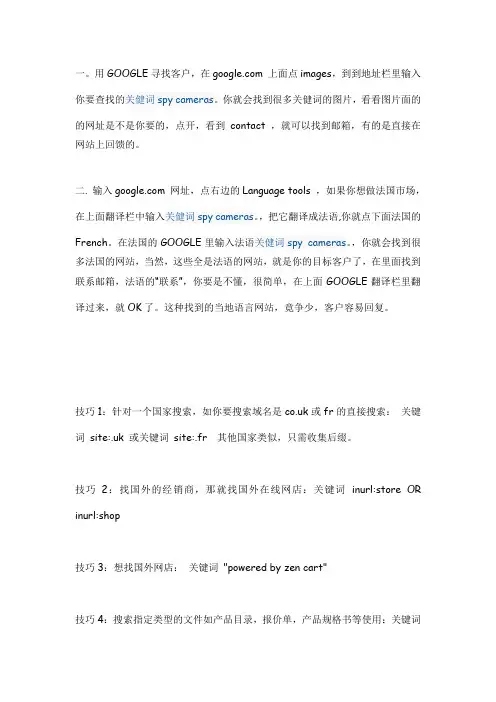
一。
用GOOGLE寻找客户,在 上面点images,到到地址栏里输入你要查找的关健词spy cameras。
你就会找到很多关健词的图片,看看图片面的的网址是不是你要的,点开,看到contact ,就可以找到邮箱,有的是直接在网站上回馈的。
二. 输入 网址,点右边的Language tools ,如果你想做法国市场,在上面翻译栏中输入关健词spy cameras。
,把它翻译成法语,你就点下面法国的French。
在法国的GOOGLE里输入法语关健词spy cameras。
,你就会找到很多法国的网站,当然,这些全是法语的网站,就是你的目标客户了,在里面找到联系邮箱,法语的“联系”,你要是不懂,很简单,在上面GOOGLE翻译栏里翻译过来,就OK了。
这种找到的当地语言网站,竟争少,客户容易回复。
技巧1:针对一个国家搜索,如你要搜索域名是或fr的直接搜索:关键词site:.uk 或关键词site:.fr 其他国家类似,只需收集后缀。
技巧2:找国外的经销商,那就找国外在线网店:关键词inurl:store OR inurl:shop技巧3:想找国外网店:关键词"powered by zen cart"技巧4:搜索指定类型的文件如产品目录,报价单,产品规格书等使用:关键词filetype:xls或关键词filetype:doc或关键词filetype:pdf技巧5:搜索产品网站使用:关键词价格下限..价格上限如USB $5..$50补充:几个限定地区搜索的技巧在google 使用关键词site:.域名后缀各国域名列表自行收集在bing搜索使用关键词loc:coutry code 国国家代码自行收集在yahoo按地区搜索关键词region:区域区域常用有africa asia\centralamerica\downunder\europe\mediterranean\mideast\northam erica\可带签名的180个国外论坛:/forum/index.php/forum/index.php/index.php/board.php/board/index.php/forums//forum///forums/index.php?act=idx/vbull//index.php//index.php/forum/index.phphttps:///search.php?search_id=unanswered /forum.php/forum/i... 107a28ed8eb4c90f54b http://www.elitepvpers.de/forum/做英文SEO必备的39个高质量国外书签网站(PR>4)1、 (PR8)2、 (PR8)3、 (PR8) (Only Blogs)4, (PR8)5、 (PR8)6、 (PR8)7、 (PR8)8、 (PR8)9、 (PR7)10、 (PR7)11、 (PR7)12、 (PR7)13、 (PR6)14、 (PR6)15、 (PR6)16、 (PR6)17、 (PR6)18、 (PR6)19、 (PR6)20、 (PR5)分享100个高PR(9,8,7)可外链的网址PR7//////////us/home/ //blog///////// //http://forum.yaml.de/// /分享400个Dofollow 国外博客:1. /blog2. /blog2. /blog/3. /4. 5. /6. /7. 8. /9. /10. /11. /12. http://www.lifeinthefastlane.ca/13. /14. /15. 16. /17. /18. /19. /谈谈邮件开发客户的技巧:有些做外贸的朋友总是会有这样的困惑,我给客户发了邮件,怎么石沉大海?或者客户给我发了询盘,我回复后没有下文了,发了几次还是没有回应。

给教师的100多个Google技巧Amber Johnson(原文地址:/100-google-tricks-teachers)现在,我们可以更容易地使用谷歌。
在课堂、功课、项目,更不用说平时的社交生活中,时间对于教师来说是非常宝贵,我们为何不利用谷歌给我们提供的广阔的世界呢?从高效的搜索,到谷歌专为教育提供的工具,以及Gmail、Google Docs(谷歌文档),Google Calendar(谷歌日历),这些工具的使用技巧一定会为您节省些宝贵的时间。
搜索技巧当您在准备研究下一个项目时,或者是查找世界各地的时间,下面这些搜索技巧都可以为您节省时间。
1. 转换单位。
不管您是要转换货币、美国和公制单位,或其它单位,尝试输入已知的单位和未知的单位就可以找到您想要的答案。
(如“10美元换欧元”,“多少茶匙等于一汤匙”)。
2. 在搜索时添加“时间记录”。
在您搜索的关键字后面加上view:timeline,在搜索结果中就会添加时间表视图,显示该关键词近期内搜索的记录。
3. 避开被封锁的网站。
如果您在访问被封锁网站遇到问题时,只需输入“cache:网址”,谷歌将会使用它的缓存副本让您打开您想去的网站。
4. 使用波浪号。
在搜索时加一个波浪号(~),可以得到一些搜索字词相关的结果。
5. 使用图像搜索。
当您试图搜索与关键词相关的图片,输入您的搜索词,然后选择图片搜索。
6. 获取定义。
如果您想不通过查字典(纸质或在线字典)就得到一个定义,输入“definition: **(查找词)”,那么即可在搜索结果中找到这个词的定义。
(例如:“definition:把握机会”,将追查“把握机会”的定义)。
7. 在特定的网站内搜索。
如果您想在维基百科(wikipedia)里找“Babe Ruth”,可输入“site: babe ruth”,即可直接找到维基百科里有关babe ruth的页面。
这个方法不仅仅适合维基百科,也适用于任何网站。
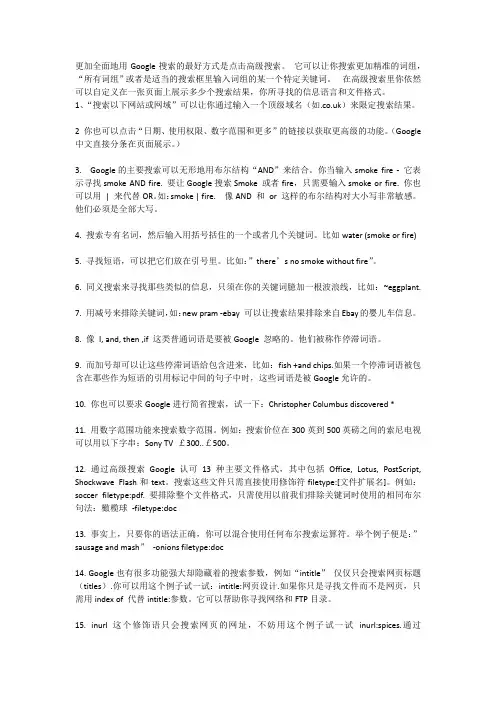
更加全面地用Google搜索的最好方式是点击高级搜索。
它可以让你搜索更加精准的词组,“所有词组”或者是适当的搜索框里输入词组的某一个特定关键词。
在高级搜索里你依然可以自定义在一张页面上展示多少个搜索结果,你所寻找的信息语言和文件格式。
1、“搜索以下网站或网域”可以让你通过输入一个顶级域名(如)来限定搜索结果。
2 你也可以点击“日期、使用权限、数字范围和更多”的链接以获取更高级的功能。
(Google 中文直接分条在页面展示。
)3. Google的主要搜索可以无形地用布尔结构“AND”来结合。
你当输入smoke fire - 它表示寻找smoke AND fire. 要让Google搜索Smoke 或者fire,只需要输入smoke or fire. 你也可以用| 来代替OR。
如:smoke | fire. 像AND 和or 这样的布尔结构对大小写非常敏感。
他们必须是全部大写。
4. 搜索专有名词,然后输入用括号括住的一个或者几个关键词。
比如water (smoke or fire)5. 寻找短语,可以把它们放在引号里。
比如:”there’s no smoke without fire”。
6. 同义搜索来寻找那些类似的信息,只须在你的关键词臆加一根波浪线,比如:~eggplant.7. 用减号来排除关键词,如:new pram -ebay 可以让搜索结果排除来自Ebay的婴儿车信息。
8. 像I, and, then ,if 这类普通词语是要被Google 忽略的。
他们被称作停滞词语。
9. 而加号却可以让这些停滞词语给包含进来,比如:fish +and chips.如果一个停滞词语被包含在那些作为短语的引用标记中间的句子中时,这些词语是被Google允许的。
10. 你也可以要求Google进行简省搜索,试一下:Christopher Columbus discovered *11. 用数字范围功能来搜索数字范围。

Google搜索结果。
技巧一:使用正确的方法无论你是使用一个简单或是高级的Google搜索,在此都存在你应该使用的某种可靠的方法。
遵循适当的方法你就能获得非常准确的结果;要是忽略这条建议的话,你也许就会看到大量不相关的结果或是缺乏你想要的相关结果。
虽然有很多不同(且同样有效的)方法用于网络搜索,我保证这个特别的方法将能带来最棒的结果。
这是一个分六步骤的过程,如下:1、首先,想好你想要寻找什么。
哪些词能够最好地描述你要寻找的信息或者概念?哪些词是你能够用来替换的?有没有那些词是可以不必包括在你想要搜索的更好定义你的需求之内?2、构建你的搜索要求。
使用尽可能多你所需要的关键词;越多越好。
如果皆存在可能的话,试着用适当的搜索操作来使你的搜索更精炼——或者,如果你愿意的话,可以使用高级搜索页面。
3、点击“搜索”按钮进行搜索。
4、评估一下搜索结果页面上的匹配程度。
如果一开始的结果与你想要的不一致,再精炼你的搜索要求并重新搜索——或转向更合适的搜索站点再进行搜索。
5、选择你想要查看的匹配的页面,点击进行浏览。
6、保存这些最符合你需求的信息。
换言之,这需要你在搜索之前思考清楚,接着在获得最初结果后精炼你的搜索。
这些多做的努力都是轻微的,但确实很值得。
技巧二:合理利用一个“与/或”的搜索大多数的用户都没有意识到,Google会自动假定一次搜索要求中所有的词之间都是一种“和”的关系。
也就是,如果你输入两个词,它就会假定你所寻找的页面是包含这两个词的。
它不会反馈给你仅包含其中一个词的页面。
这就使得你无须在输入搜索要求时输入一个“和”。
如果你想要搜索的包括“Bob”和“Ted”,你所需要做的就是输入bob ted即可。
Google会自己假定一个“和”,并自动地将它包括在内部的索引搜索内。
这与在所要求的词之间假定“或”是不同的。
例如,对比输入的要求“bob ted”(记得,这个实际上是bob和ted)与“bob或ted”。
最新利用google查找客户的方法大全使用搜索引擎找客户是外贸人员必须掌握的一门技巧,很多外贸新手都希望别人告诉自己怎么去用google搜索。
本人认为,虽然学习别人的技巧固然是必走之路,但如果一味的依赖别人总结的方法,我想,很难找到有效的客户,就算有效,也会面临相当大的竞争,因为大家都会通过这种方法来查找客户。
所以我认为,学习使用搜索引擎找客户应该从两个方面出发:一是学习搜索引擎本身的帮助说明以及随时关注新的技术的应用,另外一个就是分析客户使用搜索引擎习惯。
前者是学习搜索引擎使用技巧,后者是实际运用技巧。
前者可以通过系统学习帮助来提高,后者则需要先了解常用方法,然后自己亲自实践,特别是学习组合搜索的方法。
无论google、百度、BING、YAHOO还是别的什么搜索引擎。
以下为前人为我们总结好的关于使用google搜索客户的通用办法。
一、组合搜索搜索方法:产品+ 采购词+ 各种后缀+email一般用Google搜索客户多半是将几大元素组合起来搜索,元素之间空格即可。
一般2-4个元素组合即可:采购词如importer, distributor, wholesale, wholesaler ,wanted, buyer, buying, purchase, purchasing, looking for, interested in等等各种后缀可以是公共邮箱后缀、域名后缀、公司名称后缀等1、公共邮箱后缀Google组合搜索元素如:bearing @bearing distributor @Looking for bearing @mail.ru其他公共邮箱如@,@,@,@@yahoo.co.jp@美国:@,@,@,@,@,@cs .com,;德国 @t-online.de,@multi-industrie.de;法国:@wannado.fr,@,@,@club-internet.fr;日本 @yahoo.co.jp,@candel.co.jp;英国 @,@,@sltnet.lk;印度 @ @.in @@sancharnet.in @新西兰 @俄罗斯 @yandex.ru @mail.ru德国 @t-online.de @multi-industrie.de更多公共邮箱后缀见:如何用Google搜索买家Email 【精】2、域名后缀如.cn , .de, .fr, .us, , 更多域名后缀见世界各国域名后缀缩写域名后缀我们可以用inurl命令(注意冒号为英文字符且后面不跟空格)如:(可组合importer, purchase,looking for 等采购词)inurl:.de bearing email , 德国inurl:.fr bearing email 法国Inurl:.us bearing email , 美国inurl:.it bearing email 意大利inurl:.au bearing email 澳大利亚inurl:.br bearing email 巴西inurl:.ca bearing email 加拿大inurl:.jp bearing email 日本更多公共邮箱后缀见:世界各国域名后缀缩写3、公司名称后缀各个国家的公司名称都有个后缀,如中国的多为Co.,ltd.,其他如德国GmbH,S.P.A.,S.R.L. AG ,S.A (另外还可组合importer, purchase,looking for 等采购词)bearing GMBH email 德国bearing AG email 德国和瑞士bearing S.A. email 南欧、南美bearing S.A.R.L.email 法国、西班牙bearing B.V.email 或bearing N.V email 荷兰、比利时bearing S.P.A email或bearing S.R.L.email 意大利其他国家后缀APS: 丹麦Lda:葡萄牙Ltda:巴西、智利SP.Z.O.O:波兰TIC:土耳其S.R.O:捷克EIRL:葡萄牙、秘鲁更多公司名称后缀见:各国公司名称后缀以上元素好可以任意组合,但是基本的3项不能落下,否则搜索出来的结果更加不精确了。
Google Search API 用法1. 什么是 Google Search APIGoogle Search API 是 Google 提供的一个开发接口,允许开发者通过 API 访问和使用 Google 搜索引擎的功能和数据。
通过使用 Google Search API,开发者可以在自己的应用程序中实现类似于在 Google 搜索页面上进行搜索的功能,并获取相关的搜索结果和信息。
2. Google Search API 的基本用法2.1. 获取 API 密钥在开始使用 Google Search API 之前,你需要先获取一个 API 密钥。
API 密钥是用于身份验证和授权的凭证,用于标识你的应用程序并限制对 API 的访问。
你可以在 Google Cloud Platform 控制台上创建一个项目,并为该项目启用 Google Search API,然后生成一个 API 密钥。
2.2. 发起搜索请求一旦你获得了 API 密钥,就可以使用它来发起搜索请求。
下面是一个使用 Google Search API 进行搜索的示例代码:import requestsdef search(query, api_key):url = ""params = {"q": query,"key": api_key}response = requests.get(url, params=params)results = response.json()return results在上面的示例中,我们使用 Python 的 requests 库发起了一个 GET 请求,指定了搜索的关键词和 API 密钥作为请求参数。
返回的结果是一个 JSON 对象,其中包含了搜索结果的相关信息。
2.3. 解析搜索结果通过 Google Search API 获取到的搜索结果是一个包含了多个搜索条目的 JSON 对象。
大前提:英文Google→或第一篇在搜索框上输入:“indexof/”inurl:lib再按搜索你将进入许多图书馆,并且一定能下载自己喜欢的书籍。
在搜索框上输入:“indexof/”cnki再按搜索你就可以找到许多图书馆的CNKI、VIP、超星等入口!在搜索框上输入:“indexof/”ppt再按搜索你就可以突破网站入口下载powerpint作品!在搜索框上输入:“indexof/”mp3再按搜索你就可以突破网站入口下载mp3、rm等影视作品!在搜索框上输入:“indexof/”swf再按搜索你就可以突破网站入口下载flash作品!在搜索框上输入:“indexof/”要下载的软件名再按搜索你就可以突破网站入口下载软件!注意引号应是英文的!再透露一下,如果你输入:“indexof/”AVI另补上第二篇用GOOgle看世界!!!只要你在GOOGLE里输入特殊的关键字,就可以搜到数千个摄象头的IP地址!通过他你就可以看到其所摄的实时影象!!在google里输入inurl:"viewerframe?mode="随便打开一个,然后按提示装一个插件,就可以看到了!!!再补上第三篇三则黑客的Google搜索技巧简介大家都知道,Google毫无疑问是当今世界上最强大的搜索引擎。
然而,在黑客手中,它也是一个秘密武器,它能搜索到一些你意想不到的信息。
赛迪编者把他们进行了简单的总结不是希望您利用他去攻击别人的网站,而是利用这些技巧去在浩如烟海的网络信息中,来个大海捞针,寻找到对您有用的信息。
如果您是一名普通网民,您可以使用黑客的技巧扩大自己的视野,提高自己的检索效率;如果您是一名网管,请您赶快看看您的网站是否做好了对下面黑客探测手段的防范措施,如果没有就赶快来个亡羊补牢,毕竟隐患胜于明火,防范胜于救灾;如果您是一名黑客,相信您早以在别的黑客站点上见过类似的方法,这篇文章对您没什么用处,这里的技巧对您是小儿科,菜鸟级!您可以节省宝贵的时间做更有意义的事情,这篇文章您不用看了,到别处去吧!基于上面的考虑我编发了这篇文章。
外贸企业通过Google寻找海外买家的技巧1)Importers方法操作方法:在网络上搜索产品名称+importers这样搜索出来的结果往往是很多的B2B,行业网站,然后我们再到这些网站中查找其他的求购商机,这就是主要步骤。
小技巧:可以用importer替代importers2)关键词上加引号操作方法:搜索“产品名称importer”或者“产品名称importers”,在键入时将引号一起输入。
即上文的关键词加上引号,这样保证了搜索出来的结果中关键词是连在一起的,准确性大大提高,搜索的结果是方法十的子集。
我们用方法五是为了得出一批曝光率高的商贸网站,并首先比较全面的查找求购商机。
我们用方法十一是为了提高搜索效率。
这里要提醒外贸同行们注意的是由于各网站的搜索引擎优化处理和其它原因,同一关键词在不同时间搜索时结果是不一样的,各结果出现的次序也会变动的。
所以建议大家一个季度或再长一点的时间使用方法十重新整理一下曝光率高的商贸网站,然后在以后的3个月(一个季度时间)内使用方法十一。
3)Distributor方法操作方法:搜索产品名称+Distributor4)其他类型目标客户搜索操作方法:产品名称+其他客户类型(相关目标客户的词语除了importer,distributor,还包括buyer,company,wholesaler,retailer,supplier,vendor及其复数形式。
5)Price方法操作方法:搜索Price+产品名称6)buy方法操作方法:搜索buy+产品名称7)国家名称限制方法操作方法:在前面6种方法的基础上加入国家名称限制8)关联产品法操作方法:产品名称+关联产品名称9)marketresearch方法操作方法:产品名称+marketresearch其实可以先查一下有关那个国家,或者目标市场的中文报告。
这对把握市场是很有好处的。
10)著名买家法操作方法:产品名称+你的行业里面著名买家的公司简称或者全称11)观察搜索引擎右侧广告操作方法:搜索产品名称后,查看搜索结果右侧广告12)寻找有连接到大客户网站的网页操作方法:使用google查找大客户网站的连接这种方法查找出来的连入网页主要有如下情况:该页面有该客户的广告、该页面推荐了该客户、该页面谈论到了该客户13)寻找有引用大客户网址的网页操作方法:同上述方法,只是查找的是引用客户网址的页面,而不是连入页面14)网址包括大客户公司名操作方法:使用google高级搜索功能,输入大客户名称,在字体位置选择“网页内的网址”搜索;15)多种语言方法操作方法:搜索关键词的其他语言书写本文源于上海上弦科技有限公司。
如何利用GoogleAdWords进行搜索引擎广告投放的教程教程:如何利用Google AdWords进行搜索引擎广告投放搜索引擎广告是一种有效的推广方式,能够帮助企业吸引更多的潜在客户。
在当今数字化时代,谷歌作为全球最大的搜索引擎,其广告平台Google AdWords具有广泛的影响力和使用率。
本教程将向您介绍如何利用Google AdWords进行搜索引擎广告投放。
一、创建Google AdWords账户在使用Google AdWords之前,您需要创建一个Google AdWords账户。
请遵循以下步骤进行操作:1. 打开Google AdWords官方网站并点击“开始使用”按钮。
2. 登录您的Google账户或创建一个新账户。
3. 填写相关信息,并同意Google的服务条款和隐私政策。
4. 创建您的第一个广告系列。
二、设置广告系列广告系列是您广告投放的基本单元,它包含了多个广告组和关键字。
下面是设置广告系列的步骤:1. 在Google AdWords界面中,点击左侧菜单中的“广告系列”选项卡。
2. 点击“创建新广告系列”按钮。
3. 填写广告系列的相关信息,包括广告系列名称、出价、定位和广告展示时间等。
4. 选择广告系列的目标受众和投放地理位置。
三、创建广告组广告组是广告系列的子集,它可以根据不同的主题或关键字进行区分。
以下是创建广告组的步骤:1. 在Google AdWords界面中,点击左侧菜单中的“广告组”选项卡。
2. 选择您要添加广告组的广告系列。
3. 点击“添加广告组”按钮。
4. 填写广告组的名称、关键字和预算等相关信息。
四、选择关键字关键字是您广告的触发条件,当用户在谷歌搜索这些关键字时,您的广告将有机会展示在他们面前。
以下是选择关键字的步骤:1. 在Google AdWords界面中,点击左侧菜单中的“关键字”选项卡。
2. 输入您认为与您的广告相关的关键字。
3. 根据Google AdWords提供的搜索量和竞争度数据,选择适合的关键字。
外贸中,使用Google搜索客户,主要包含这几种情况:
1.有了自己的{行业和产品},要搜索相关的{客户公司名}
2.有了{客户公司名}或者{客户网站},但是找不到{客户邮箱}
3.有了{客户公司名}和{客户邮箱},但是不知道他们的具体{联系人名字}
4.搜到很多的结果,但是大部分都是不相关的网页,上面{没有联系方式}
5.想搜索{特定国家的客户},但是搜索出来的结果都不是我想要的。
谷歌搜索的一个重要概念就是相关性。
只要我们利用好已知信息,绝大多数情况,都是搜索到我们想要的结果的。
接下来我们就根据上面的逻辑逐一分析,该如何通过已知信息,搜索到目标信息。
介于大家无法访问谷歌,放一个可以用的谷歌地址:
/googlesearch
1.有了自己的{行业和产品},要搜索相关的{客户公司名}
普通的搜索方法一般是直接在谷歌搜索框中输入自己的行业或者产品进行搜索,但是这样的方法搜索出来的结果十分广泛,有的人会加上importers,wholesaler等修饰词,但是结果仍然不精确。
如果想仅仅通过自己的行业和产品关键字就搜到比较精准的客户名单,可以试试以下几条谷歌语法:
intext:"行业或产品"+"retailer" -B2B -Marketplace -leads -cn
intext:"行业或产品"+"importer" -B2B -Marketplace -leads -cn
intext:"行业或产品"+"wholesaler" -B2B -Marketplace -leads -cn
强烈推荐:产品名称--B2B --Marketplace --leads --platform --directory --connecting
--"Find -Suppliers" --"Find -Manufacturers" --member --buyers --China --Chinese
--forum --"yellow -pages" --yellowpages --online --shop --store --blog --wikipedia --youtube
2.有了{客户公司名}或者{客户网站},但是找不到{客户邮箱}
有时候,知道了客户的公司名称,但是还没有具体的邮箱,可以通过以下几条搜索命令搜索知道客户公司名称,搜索公司邮箱:
intext:"公司名称"+"email * *"
“mail * * @公司根域名”
3.有了{客户公司名}和{客户邮箱},但是不知道他们的具体{联系人名字}
知道公司名称,搜索该公司联系人:
intext:"公司名称"+"contact"
intext:"公司名称"+"contact person"
intext:"公司名称" inurl:contac
知道公司邮箱,需要该公司联系人:
intext:"公司邮件域名"+"contact person"
其实,很多国外的公司,邮件地址本身就包含了联系人的名称,不妨直接使用这个名称称呼客户,比如:Caroline.Coakley@这个邮件地址,很明显邮箱的主人,名字就是Caroline Coakley。
还有些不是这么明显的,其实也可以利用起来,比如:
d.kumer@这个地址,写邮件的时候直接称呼他Dear Mr. D. Kumar。
只要多动动脑筋,还是有很多方法的,就看怎样去灵活地使用。
4.搜到很多的结果,但是大部分都是不相关的网页,上面{没有联系方式}
在搜索的时候,遇到的一个比较头疼的问题,就是有很多搜索出来的网页,都不是我们想要的,而是一些类似B2B,广告等页面,虽然在手机公司名称的时候,可以用来获得公司名,但是由于很多都没有联系方式,所以实际的用处不是很大。
这个时候,可以使用一些语法将这些不需要的结果排除掉,只要在原有的搜索语句后面加上一下的语句,就可以起到相应的作用了:
去除B2B网站和黄页
-B2B -Marketplace -leads -directory -member -yellowpages -online - "join free"
-Categories -\"Find Suppliers\"
去除国内网站
-China -Chinese
去除无关网站(论坛视频招聘)
-forum -blog -wikipedia -interviews -Resumes -Industries

5.想搜索{特定区域的客户},但是搜索出来的结果都不是我想要的。
不同的行业和产品,需要锁定的目标市场也有差异。
但是用谷歌搜索出来的结果,是全球性的。
这个时候,使用基于国家的筛选方法,可以让你找到特定区域的目标客户。
只在你的搜索条件前面加上一个命令就可以了:
Site:.国家后缀比如搜索英国的网页,就在前面加上site:.uk 搜索印度的网页,就在前面加上site:.in,以此类推
注意:这个方法会将那些使用com,net,org等域名的网站排除掉,所以结果并不是完整的,建议使用多种方法都搜索一下,互为补充。
各个国家的域名后缀列表如下:
图片:8.各国域名后缀.jpg
如果这个图片看不清,可以下载TXT版本的:/s/1pmjts。